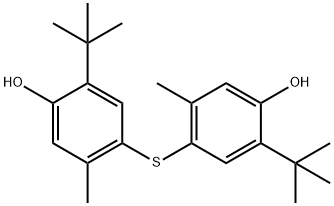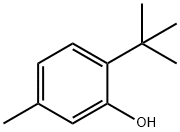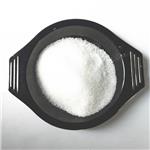Description
4,4'-Thiobis(6-tert-butyl-m-cresol) (Antioxidant 300), melting point 161-163℃, white powder, low volatility, low toxicity; soluble in organic solvents such as benzene, toluene, acetone, methanol, ethanol, carbon tetrachloride, slightly soluble in petroleum solvents, insoluble in water, is a non-polluting, high-efficiency phenolic antioxidant with low volatility, high antioxidant efficiency, good thermal stability and weather resistance, and little effect on the electrical properties of the product. It also has a synergistic effect when used with carbon black and octadecyl alcohol. It can be used as an antioxidant for polypropylene, ABS, polystyrene, polyphthalamide, polyurethane, etc., and is suitable for white, bright-colored and transparent products. It has very low toxicity and is allowed to be used in plastic products that come into contact with food in many countries.
Chemical Properties
4,40-Thiobis(6-tert-butyl-m-cresol) is a light gray to tan powder. Aromatic odor.
Chemical Properties
white to almost white crystals or crystalline
Uses
4,4''-Thiobis(2-tert-butyl-5-methylphenol) is an antioxidant in the rubber and plastics industry. 4,4''-Thiobis(2-tert-butyl-5-methylphenol) is a radical inhibitor which prevents the thermal decomposition of the peracid. In addition, it is used as a stabilizer in polyethylene and polyolefin packaging materials for foodstuffs. Protection of light-colored rubber from oxidation and of nonstaining neoprene compounds against deterioration.
General Description
White or light gray to tan powder.
Air & Water Reactions
Sensitive to base hydrolysis and may spontaneously oxidize in solution. . Insoluble in water.
Reactivity Profile
4,4'-Thiobis(6-tert-butyl-m-cresol) may be sensitive to light.
Hazard
Toxic by inhalation. Upper respiratory tract
irritant. Questionable carcinogen.
Health Hazard
4,4'-Thiobis(6-tert-butyl-mcresol)
(TBBC) is of low systemic toxicity in
animals; allergic contact dermatitis has been
reported in humans.
Fire Hazard
4,4'-Thiobis(6-tert-butyl-m-cresol) is combustible.
Flammability and Explosibility
Non flammable
Safety Profile
Poison by
intraperitoneal route and probably by
ingestion and inhalation. Mutation data
reported. See also SULFIDES. When heated
to decomposition it emits highly toxic fumes
of SOx.
Synthesis
2-tert-butyl-5-methylphenol (164.2, 1.0mol), silver nitrate (169.9, 1.0mol), iodine (253.8g, 1.0mol) and dichloromethane 0.7L is added to the reactor, stirred at room temperature under light-proof conditions, and the colour of iodine gradually disappears, accompanied by the generation of silver iodide. After 30 min, the generated silver iodide is filtered and recovered, and the filtrate is washed with 1.1L water and recycled for washing Water. After the organic phase is dried with industrial anhydrous magnesium sulfate, Cu (8.2g), thiourea (38.1g, 0.5mol) and triethylamine 200g (about 273ml) are added inside and then reacted for 4 hours under reflux. After the reaction terminates, it is naturally cooled to room temperature, and the Cu catalyst is filtered and recovered; then water is added for dilution and washing, and after separating the aqueous phase, the organic phase is added with water again, and the pH is adjusted to 6-7 with phosphoric acid, and the aqueous phase is separated after standing. The organic phase was washed with saturated sodium chloride aqueous solution and water, respectively, dried with industrial magnesium sulfate, distilled under reduced pressure, and dichloromethane was recovered, then recrystallized with ethanol. 159.5 g of 4,4′-thiobis(6-tert-butyl-3-methylphenol) was obtained.
Potential Exposure
This material is used as an antioxidant in the plastics and rubber industries; in Neoprene and other synthetic rubbers; in polyethylene and polypropylene.
Carcinogenicity
TBBC was not mutagenic in Salmonella
typhimurium strains with or without metabolic
activation. In Chinese hamster ovary cells,
TBBC induced an increase in sister chromatid
exchanges but there were no increases in chromosomal
aberrations.
Incompatibilities
Incompatible with oxidizers (chlorates, nitrates, peroxides, permanganates, perchlorates, chlorine, bromine, fluorine, etc.); contact may cause fires or explosions. Keep away from alkaline materials, strong bases, strong acids, oxoacids, epoxides. May evolve explosive hydrogen sulfide upon contact with moisture or acids.






